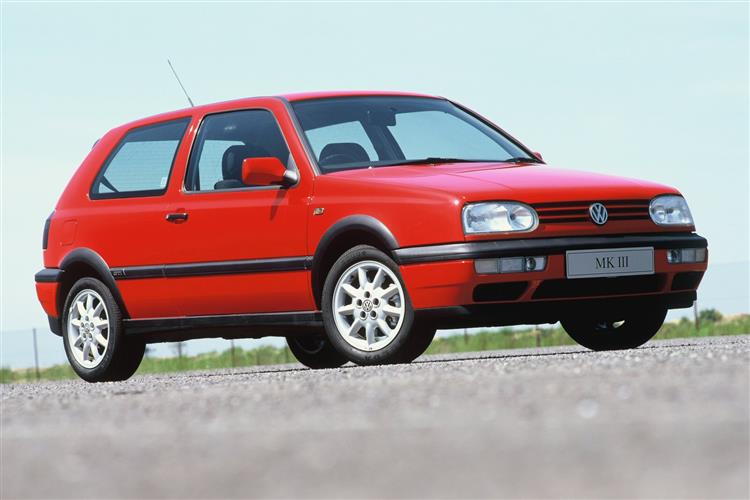THE GTi OF THE BEHOLDER (some text hidden) --NONE--
BY ANDY ENRIGHT
Introductionword count: 124
When most enthusiasts consider the Golf GTi, they make a mental division. The MK1 and Mk2 cars were the ones that established the GTi legend, and the Mk3 versions represented the GTi sinking into comfy middle age. For the most part, this is pretty accurate, but Volkswagen seem to have realised that neglecting the family jewels in this manner hasn't done them too many favours and is busy rebuilding the GTi legacy. As used propositions, it's difficult to fault the Mk 3 cars. Bigger, better built and with less of a tyre smoking image, they make a good deal of sense both to those who still have a glint in their eye and the large proportion who simply want a well specified Volkswagen Golf.
Modelsword count: 20
Models Covered: Golf GTi Mk 3 - 1992-1997 (2.0 8v, 2.0 16v three and five-door hatch [GTi, Colour Concept, Anniversary])
Historyword count: 588
TheMk3 Golf arrived in 1992, and was promptly christened 'Car of the Year' but few drivers raved over its dynamic qualities largely because it was bigger, safer and heavier. Despite that curvaceous body being very slippery, with a drag factor between 0.30 and 0.33, it was very heavy. The original GTi weighed 844 kg, and the MK3 was up to 1032 kg. The GTi version's power-to weight ratio had slipped from 133 bhp per ton to 113. That translated into a top speed of 124 mph and a so-so 0-60 mph time of 8.7 seconds - surprising, as the GTi now had a larger 2.0-litre engine that cranked out 115bhp. Few doubted that it did look the part, however, with colour-coded two-bar grille, black wheelarches and bumper extension, rear spoiler, tinted rear light clusters, 6.5Jxl 5 in Long Beach alloys and twin exhaust pipes. Inside came sports seats, electric windows, on board computer and height-adjustable sports steering wheel. Handling-wise it was a lot softer and more refined. It was effectively a modified Mk2 set-up with standard power steering. From September 1992 came split rear seats and, a year later, passenger seat height adjustment formed part of the package. October 1994 was safety month, as ABS brakes, driver's airbag and immobiliser were included -- but a sunroof became a cost option. July 1995 saw the arrival of rounded side indicators and a bee sting aerial. May 1996 marked the 20th anniversary of the GTi, hence the 600-unit limited-edition Anniversary, with red alloys and traditional golf ball gearknob. King of the limited editions though was the Colour Concept, in April 1995, available in yellow, red, blue or green, with matching leather Recaros, silver-faced instruments and 6.5 in Solitude alloys. The eight-valve was finally deleted in November 1997. Only twenty-four months after the 2.0-litre 8-valve GTi failed to create a favourable impression with GTi die-hards, Volkswagen decided that another 16-valve version was required. It had worked for the Mk 2, so reason dictated that such a recipe would also work for the Mk 3 and so in January 1993 this car duly arrived. Beneath the familiar 16 valve head was the 2.0-litre unit, which produced 150 bhp at 6000 rpm. Acceleration improved, which meant that 60 mph arrived in around eight seconds. Top speed was a punchy 134 mph. The five-speed gearbox was a carry over from the GTi, as was the suspension -- unfortunately. So it was secure, safe, but a bit roly-poly, and still not enough fun. Interestingly, it came with the traction control system, as used on the VR6, which meant that it worked with the ABS system to eliminate torque steer (weaving as you bury the throttle) by monitoring the speed of the driving wheels. Standard specification was pretty much as the 8-valve, plus Monte Carlo alloys, bee sting aerial with amplifier, plus a brake lining wear indicator. September 1993 heralded the arrival of passenger seat height adjustment, as the five-door model got rear electric windows. For October 1994, a driver's airbag and engine immobiliser were fired. July 1995 saw the arrival of those neat rounded wing-mounted indicators. May 1996 -- the GTi's 20th anniversary year -- saw the launch of the special edition Anniversary. Just 150 were imported in three- and five door body styles, at a cost of £16,995 and £11,425, respectively. They had red alloy wheels, a Sportsline interior trim, red bumper stripes and the iconic golf ball gearknob. This model was also discontinued in November 1997 to make way for the Mk 4.
What You Getword count: 104
The Mk3 GTi is a car that is built to last, good to drive and offers safe and solid motoring for not too much money. They offer a civilised alternative to many other hot hatches and are usually worth more second-hand than most rivals. You're paying for the Volkswagen name and reputation to some extent, but don't forget that though a Golf costs a bit more than some rivals, it will equally be worth more and probably be in better condition when the time comes for you to sell it on. Just don't expect a sports car in the mould of a Peugeot 306GTi.
To see the full road test text contact us on 0330 0020 227
Pictures (high res disabled)

Scoring (subset of scores)
Category:
| Performance | |
| Handling | |
| Comfort | |
| Space | |
| Styling, Build, Value, Equipment, Depreciation, Handling, Insurance and Total scores are available with our full data feed. | |



